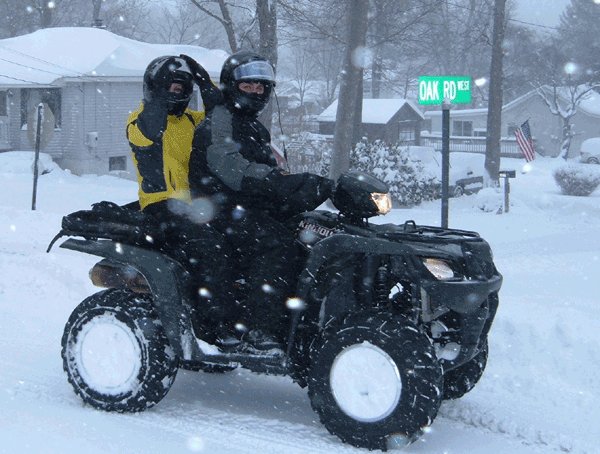Latest Forum Topics
Showing topics posted in for the last 365 days.
- Today
-
Good opportunity to revive an older topic. 😁 For anyone 6 and older, check out the following Kawasaki KFX 50 Polaris Outlaw 70 Suzuki Quadsport Z50
-
94 Kawasaki Mojave 250 - No spark, Very confused
Mech replied to justent_88's topic in Kawasaki ATV Forum
Simple test is to look for a pulse of voltage coming out of the stator plug. Most of the wires will have a regular AC voltage and be insulated from the earth, and one wire or a pair of wires will have a pulse. - Yesterday
-
I'm pretty sure the oil pump will have a spring loaded valve(check valve) to prevent oil from the oil tank draining straight through the pump and into the engine. The weight of oil under the influence of gravity isn't enough to open the valve, but the vacuum/pressure applied to the oil by the pump does open the valve. To test that valve you might be able to disconnect the hose going from the pump to the carb or inlet and watching to see there is no slow leak of oil from it. I say might because I'm not sure that will have a oil pipe, some models might pump oil through a hole in the cases to the main bearings. If the oil isn't leaking out of the hose it may be leaking from the pump into the engine due to wear, but, even with wear it should only leak when it's not running, if the check valve I described isn't working. And.. All that said.. Are you sure it is oil overflowing out of the engine ? Those oil tanks don't hold much oil. Are you sure it's not fuel with a bit of oil in it ? Have you checked the fuel tap is operating properly ? And to answer your questions.. The insides of older two-strokes were lubricated by oil mixed into the fuel in the fuel tank. In those models they got too much oil at light duty, or too little oil under sever conditions, depending how much oil you pre-mixed into the fuel. In later models they used a small oil pump to inject oil into the carb or inlet. The pump is adjusted by a cable from the throttle so that the pump puts out more oil at larger throttle settings. That tends to ensure the engine gets the right amount of oil for the load it's under. That system though still didn't distribute the oil to the critical places as well as we might hope so in even later designs they started pumping the oil straight to the main bearings and it got mixed and distributed with the fuel to lubricate the rod and pistons in the crankcase. Some models they used oil straight to the bearings, and to the carb or inlet, at the same time, using hoses or drilled passages. .
-

94 Kawasaki Mojave 250 - No spark, Very confused
justent_88 replied to justent_88's topic in Kawasaki ATV Forum
Thank you for the reply, Mech. I'll have to go and try this later. I was struggling to remove some of the flakes last week, but i guess i need to go back and get it as spotless as possible. I really appreciate your response. Hopefully everything works out. -
94 Kawasaki Mojave 250 - No spark, Very confused
Mech replied to justent_88's topic in Kawasaki ATV Forum
It only takes a single flake of steel, bridging between the trigger coil's steel core and the flywheel, to short out the magnetic field between the flywheel and the trigger coil's pole, and the cdi won't fire. A build up of iron dust on the trigger pole can do the same thing. You need to get an analogue volt gauge and check there is a pulse of voltage getting to the cdi. A digital gauge won't always detect the brief pulse but the needle on the analogue gauge will flicker so you see it. Some kawasaki use a 12v system of ignition so if the trigger pulse is getting through and it still isn't sparking then we need to get a manual and check the resistances and output voltages of the stator. If there is no pulse from the trigger coil then you check there is continuity from the cdi unit to the trigger coil and if that's ok you need to take the side cover off and get every flake of steel off the flywheel and stator pole. Steel flakes or dust can also short out the charging cores of the stator. The best way I've found for getting dust or flakes off is to use a rag and grab it and wipe it off. It takes a while fighting the magnetism but eventually it's possible to get every little flake out and enough dust off to prevent it bridging the gap between pole and flywheel. -
Greetings, Have a 88 LT80 that been sitting for a couple years. Bought a new piston, cylinder and head. Installed these, rolled it over and it quickly locks up. Took carb apart. It was full of what appears to be 2 cycle oil. Cleaned it, but keeps locking up and 2 cycle oil continues to seap from exhaust port. When i installed new cylinder, I noticed crankcase was full of oil. I'm now wondering if that oil is what's getting sucked up into cylinder. Should there be no oil in crankcase? If that the case, how is crank and rod lubricated? Sorry, never worked on a 2 stroke. Thanks!
-
Hello, im looking for some input on this situation i have. My 94 Mojave has no spark, and i have no idea what it is. Ive replaced/tested the magneto, the pickup coil, cdi, the ignition coil. Even the key and Killswitch. I haven't tested the harness its self, but i have tried another harness and still nothing. The only thing i can think of is the fly wheel itself. I have found a lot of metal shavings in the fly wheel and have cleaned it the best I could. But nothing happened afterwards. I am truly stumped here and hoping some of yous could shed some knowledge/ideas that could help get this thing to fire.
- Last week
-
Well, as an update, and hopefully save others the time and cost of parts, after replacing the fuel cut off, rectifier and kill switch, and stripping and testing every wire and connection, I checked the carb again. Although I had taken it apart and cleaned, then blown it through with the airline, I had missed a tiny grass seed which was stuck in the main jet!! After poking it out with a strand from a wire brush, she fired up and revs a treat!! Just shows you that even after 50 years working on motors, even an old fart like me can still make "rookie" mistakes!!🙃DOH!! Thanks again to everyone for their help👍, ps, all the answers deserve a "tick" as being most helpful.
-
I found some seat covers on Amazon for $35 and decided I would give them a try. I took the old cover off and cleaned the foam with bleach and water solution. I left the foam in the Sun and it killed off all the remaining mold. I watched a few YouTube videos and bought some stainless steel staples. The cover went on with a lot of stretching. I paid a lot of attention to removing wrinkles and getting the seams straight. There were a lot of temporary staples needed to tack after stretching. I took my time and the seat turned out great. I will take pictures for my next post. Thanks for your posts
-
Ouch ! How did that happen ? Yeah it looks like part #1 800398.
-
That does sound mighty like what it could be Gw.. Good call. I'd still clean and lube the moving parts of the sheaves though when changing a belt. It's important they are all moving nicely or the gear ratios and so load on the engine get out of whack, and that could cause the belt to slap more than it should.. But I'll bet Gw's right.. Even if the ratios are hanging a bit high, it can probably be overcome by either throttling off slightly, or changing gear.
-
Variations of zinc have been used as friction reducers for a long long time. That does work. Quad bikes have a lot of roller and ball bearings though, and those don't wear from friction, they just work and flex the surface until it starts lifting off. A friction reducer in the oil of a quad would help piston scuff and gear wear, and a few bronze bushes, but you wouldn't want to get it on a wet clutch.. It wouldn't be good if you had a catalytic converter on your bike either.. Or perhaps, an O2 sensor.. not sure about that though but they are generally pretty sensitive.
-
I can see the photos now and from what i can tell from the parts diagram it is part #1800388 Rear wheel axel bearing seat. Click on it and says part is no longer available. That may be a hard find, but i would look on ebay. You might also do an internet search with the part number and find a new old stock one floating around.
-
here is the parts diagram where I think I see it visually in the image... but when i scroll down the list I dont see axle housing? idk... here is the link to where i was looking at the diagram. https://alpha-sports.com/eton2_parts.htm?fpg=/eton/2005Yukon(YXL-150)/25.htm
-
Check if you can see the photo now?? Idk what the deal is with my photos not working on here. I tried posting these ones with a different method this time.
-
-
idk what keeps happening with the pictures. let me know if you can see these ones
-
-
Interesting stuff it claims its smart nano technology and only sticks to bearing surfaces, but then it shows a photo of how it repaired scratched piston rings.
-
Anti friction is good, but I'm dubious about their claims it repairs wear. I mean, if it builds up a hard layer on metal, how does it know the difference between crank shaft and bearing journal, and if it builds up the surface, by how much, and does it cater for the different clearances required between roller and shell bearings. If it only puts on a layer one nano-particals thck, then that's not going to effect several thou of wear, and if it keeps building up thicker and thicker, then how does it know to stop building up for the required clearances things need to allow for expansion and oil flow. Truth is it's probably no better than any of the other friction reducing compounds we use.. nano or not.
-
Recent Status Updates
-
Hello All· 0 replies
I just joined the Forum and this Club. I'm a retired Auto and RV Mechanic. I tinkered with Dirt Bikes in the past, but now have gotten the Quad Craze and so here I am. I hope to bring more to the table then questions, lol. I will gladly contribute were I can! I am looking for a project. I'm intrigued by the Suzuki King Quad 4x4 or a Bayou 300-400 4x4. Any thoughts or advice is greatly appreciated!! Thanks!
-
Tell a friend
-
Gallery











